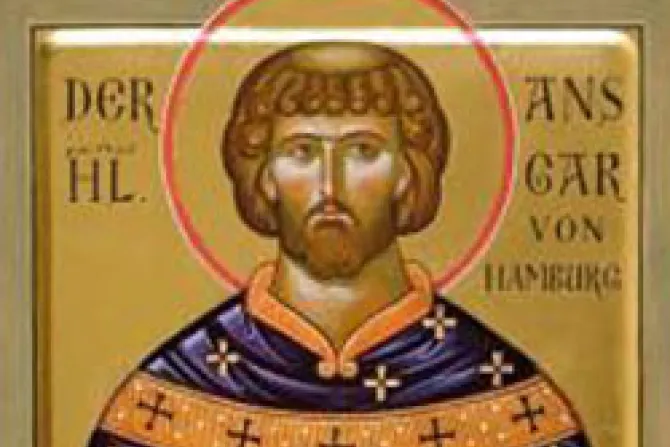Denver, Colo., Jan 30, 2011 / 06:01 am
Although Feb. 3 is more commonly celebrated on the liturgical calendar as the feast of St. Blase, it is also the memorial of St. Anskar, a remarkable missionary who risked his life to bring the Catholic faith to Scandinavia during the ninth century.
Anskar was born in 801, just a year after Pope Leo III bestowed the title of emperor on the Frankish King Charlemagne. Between 772 and 805, the emperor would achieve the dubious feat of spreading Christianity to the northern Saxon tribes through a process of conquest and forced conversion.
Eventually in his missionary work, Anskar would continue this northward extension of the Church. However, he would employ very different means in his attempt to convert the northern tribes, seeking to impart the faith through his inspired preaching and exemplary life.
Anskar was brought up among Benedictine monks in northern France and received his own monastic calling shortly after the death of Charlemagne in 814. A number of visions and dreams, which he had experienced from a young age, culminated in a vision of supernatural light, accompanied by a command to surrender his life for the sake of God's kingdom.
“The majesty of almighty God was revealed to me,” he later recalled. “A most sweet voice, the sound of which was more distinct than all other sounds, and which seemed to me to fill the whole world, came forth from the same divine majesty, and addressed me and said: 'Go and return to Me crowned with martyrdom.'"
Anskar never became a martyr in the literal sense, but he undoubtedly gave himself in a sacrificial way to the service of the Church from that time onward. This service intensified when his Benedictine community moved in 822 to northwestern Germany, where Anskar took up the work of heading the monastery school and giving religious instruction to the public.
In 826, Charlemagne's imperial successor –his son known as Louis the Pious– sought the service of the German Benedictines in evangelizing the pagan kingdom of Denmark. The abbot suggested Anskar undertake the mission, and he gladly accepted. Only one other monk in the community, named Aubert, was willing to accompany Anskar on the dangerous mission, while the others refused and asked him to reconsider.
While Anskar outwardly accomplished little during his first two years in Denmark, he did found a school for children, instructing them in the Catholic faith in hopes that they could eventually participate in the conversion of their country. But eventually King Harald, who had welcomed the missionaries following his own conversion, fell out of favor with the people, forcing Anskar's exit as well.
In the nearby kingdom of Sweden, the pagan king presided over a traditional religion that considered him a descendent of the gods, and which encouraged ancestor-worship, human sacrifice and polygamy. Word came to Emperor Louis that many Swedes had learned of the Christian religion and wished to convert, prompting him to request Anskar's service again.
Anskar and his companion Witmar were robbed by Vikings on the way to Uppsala, then the Swedish capital and a center of pagan worship. He obtained permission to preach from Sweden's King Bjorn, and made steady progress for two years before returning to Hamburg to be consecrated as a bishop. Returning to the Scandinavian territories, the new bishop continued to form monasteries and schools.
A tragic period in Anskar's later life began in 845, when King Eric of Jutland led an invasion that laid waste to his diocese. Anskar spent the next four years wandering throughout the desolate land, attempting to care for the remaining Catholics and rebuild the destroyed churches.
Then, after being named Archbishop of Bremen in 849, Anskar took an astonishing step. Approaching the same King Eric, with almost unimaginable humility, he sought – and received – permission to preach the Gospel in his realm. He returned to Denmark, where he soon encountered a number of Danes who had secretly become Christians and now wished to worship openly.
He returned to Sweden four years later, after receiving encouragement in a vision from his late former abbot, and strengthened the Christians who were experiencing persecution under King Eric's successor. In 854, he returned to Hamburg, where he spent the last 11 years of his life. One of his most notable accomplishments during this time was in negotiating the release of many Christians who had been kidnapped by members of hostile pagan tribes.
Near the end of his life, the bishop – known for his extremely conscientious ways – became worried that he had not become a martyr, as he was asked to do in his youth. Eventually, however, he received a revelation from God that allowed him to accept the judgment of his disciple, biographer, and successor Rimbert – that “his whole life was like a martyrdom.”
“He endured many labours amongst foreigners apart from those within his own diocese,” Rimbert wrote of Anskar, “which were caused by the invasions and ravages of barbarians and the opposition of evil men – and in addition, the personal suffering which, for the love of Christ, he never ceased to bring upon himself.”
St. Anskar died on Feb. 3, 865. He would be known to subsequent generations at the “Apostle of the North.”
(Story continues below)


